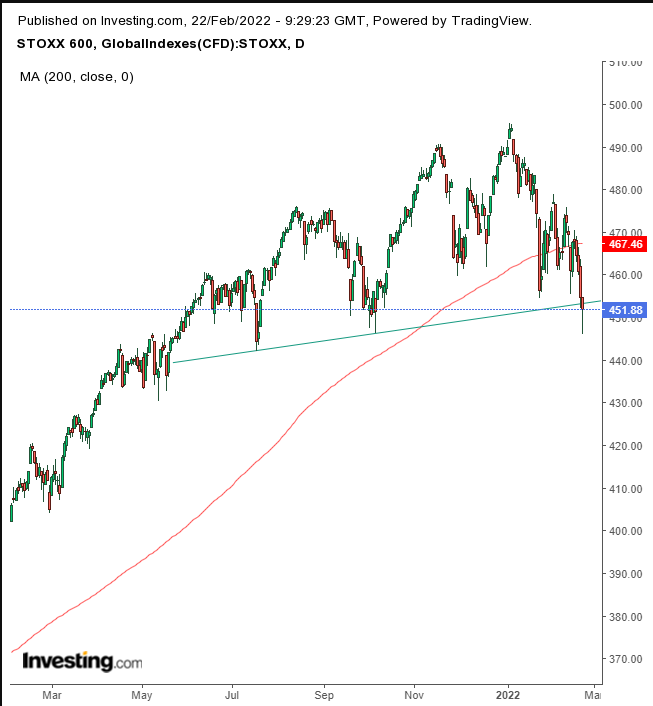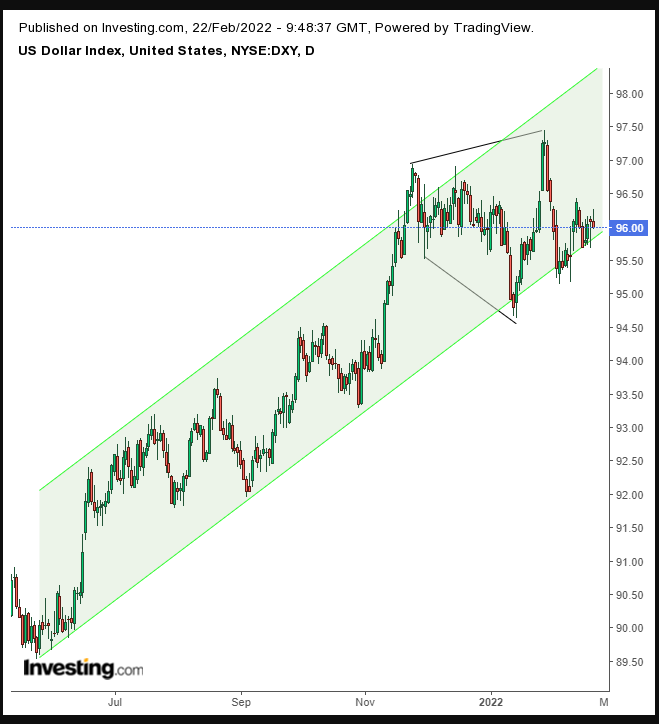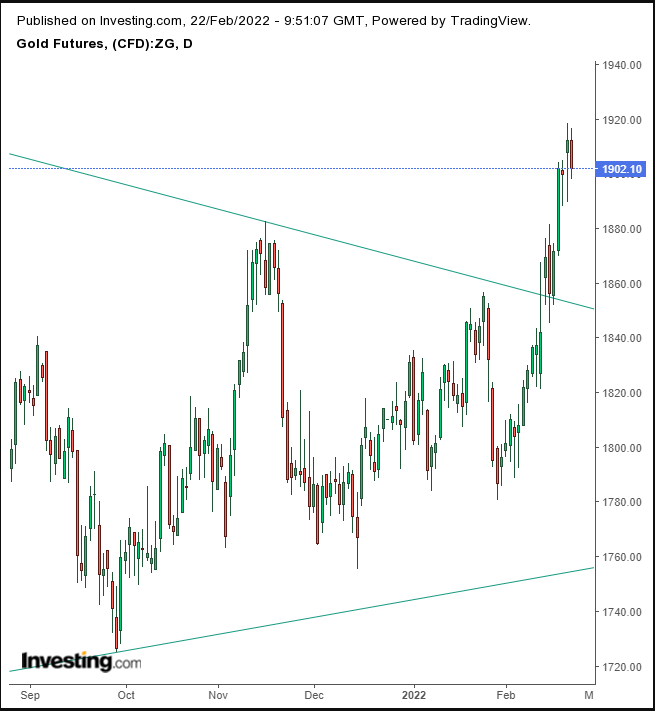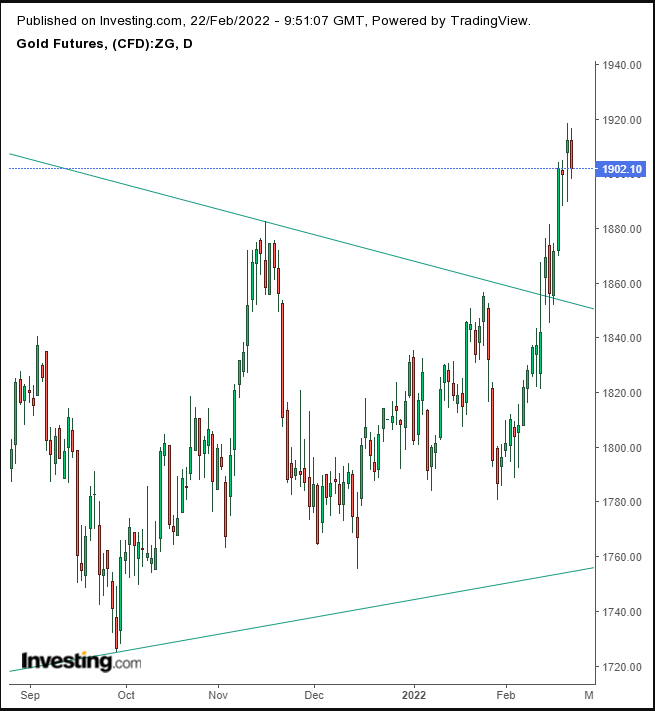- Heightened volatility roils markets as war fears escalate
- Oil nears highest levels since 2014
- Aluminum reaches 13-year high
Key Events
US futures on the Dow Jones, S&P 500, NASDAQ and Russell 2000 were all volatile on Tuesday, along with Asian shares while European indices fluctuated after Russia sent troops into Eastern Ukraine.
US Treasuries surged along with oil, aluminum and nickel on the rapidly rising potential for full out war which could also create supply disruptions.
Global Financial Affairs
The Russian MOEX fell 6.75%. It was the fourth day of losses for the stock index, for a total decline of 22.1% so far. The extreme drop followed Russia's 'recognizing' the independence of Ukraine's two separatist-controlled regions, and President Vladimir Putin sending troops into those areas. Since the pandemic, the Russian ruble has been on a downward spiral, nearing a two-year low.
Contracts on the NASDAQ 100, which had posted the strongest gains during the height of the coronavirus pandemic, led this morning's earlier selloff among US equity futures, but have recovered somewhat. US markets were closed yesterday for the Presidents' Day holiday.
European stocks listed on the STOXX 600 Index plummeted nearly 2% at the open but then the pan-European benchmark rebounded ten minutes into the session and has been paring losses at the time of writing.

The STOXX 600 was struggling with the neckline of a top, having cut through the support of the 200 DMA for the first time since 2020. If the price closes at these levels, it will have produced a hammer, a powerful bullish candle equal to its long lower shadow.
Earlier today, Asian shares were the first casualties of the decision by President Vladimir Putin to send troops into the breakaway states in the eastern part of Ukraine. Hong Kong's Hang Seng underperformed, plunging 2.7%, while China's Shanghai Composite retreated less than 1%.
Treasury yields on the 10-year note opened lower amid a dash into the ultimate safe haven.

Yields are struggling to climb back into their rising channel. The recent pennant's support will be put to the test. Below that awaits the much larger symmetrical triangle, a continuation pattern within the uptrend.
The dollar gained earlier today, but has now moved slightly lower.

The greenback has resumed a lateral move since late November while remaining within its rising channel.
Gold dropped below the $1,900 level after having pushed past $1,918 during intraday trade on Monday, as Treasuries attracted more investor funds.

The yellow metal may be ripe for a return-move to test the large symmetrical triangle from which it broke out of a week ago.
Bitcoin slipped again, making it the third day of declines for the cryptocurrency.

Last week, the digital token completed a small double top, itself a return-move to a near-six-month-long H&S top.
Concerns that any conflict could lead to supply issues have driven commodity prices higher. Oil was trading up 1.2% from its Feb. 14 peak, the highest level for the energy commodity since Sep. 3, 2014.
Nickel opened 3.5% higher, its fourth consecutive gap, making this a dangerous time to get into the metal, especially as it nears its highest levels since 2011.
Aluminum opened 3% higher, reaching a 13-year high.
Up Ahead
- Eurozone CPI data is published on Wednesday.
- EIA crude oil inventory report is released on Thursday
- On Thursday the US reports quarterly GDP figures
Market Moves
Stocks
- The STOXX 600 fell 0.7%
- Futures on the S&P 500 fell 1.2%
- Futures on the NASDAQ 100 fell 1.9%
- Futures on the Dow Jones Industrial Average fell 1%
- The MSCI Asia Pacific Index fell 1.5%
- The MSCI Emerging Markets Index fell 1.4%
Currencies
- The Dollar Index was little changed
- The euro rose 0.4% to $1.1350
- The Japanese yen rose 0.3% to 115.10 per dollar
- The offshore yuan was flat at 6.261 per dollar
- The British pound fell 0.2% to $1.3574
Bonds
- The yield on 10-year Treasuries declined four basis points to 1.89%
- Germany's 10-year yield rose four basis points to 0.21%
- Britain's 10-year yield rose one basis points to 1.42%
Commodities
- Brent crude rose 3% to $95.40 a barrel
- Spot gold fell 0.5% to $1,896.04 an ounce
